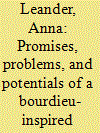| Srl | Item |
| 1 |
ID:
173465


|
|
|
|
|
| Summary/Abstract |
Immediately following the Battle of Chamdo in October 1950, during the period between November 1950 and April 1951, the leaders of the new People's Republic of China (PRC) had two priorities in regard to Tibet. The first was to persuade the Tibetan government to send delegates to Beijing as soon as possible in order to start “negotiations,” and the second was to prevent the Dalai Lama from fleeing Tibet. Using Chinese documents that offer a new version of the process that led to these “negotiations,” this study, without addressing the international issues in detail, illustrates how the leaders of the PRC, either with promises, threats or even by bluff, were able to attain their goals.
|
|
|
|
|
|
|
|
|
|
|
|
|
|
|
|
| 2 |
ID:
108240


|
|
|
|
|
| Publication |
2011.
|
| Summary/Abstract |
The promise of Bourdieu-inspired analysts to provide a "different reading" of the international is receiving increasing attention in the academic discipline of international relations (IR). This attention also generates awareness and of problems inherent in the Bourdieuian approach and a desire to develop it further (or abandon it). These discussions have often focused on the difficulties that arise for IR as a consequence of the structuralism of Bourdieu's approach, and as such they dovetail with the discussions between Bourdieu's "critical sociology" and the "pragmatic school" in the French context. This article uses these discussions to clarify what it entails to paint a different picture-my picture-of the international using Bourdieu's thinking tools. More specifically, it argues that Bourdieu's thinking can be used as a basis for a non-structuralist staging of the international taking on board the critique raised by pragmatists and integrating many of the insights developed by them. Bourdieu often referred to his own thinking as a "structuralist constructivism," so this article takes Bourdieu's thinking in a direction he may not have liked to go. However, it sticks closely to the spirit of his contention that one should never privilege scholastic theorizing for the sake of theorizing nor hesitate to "read a thinker against himself."
|
|
|
|
|
|
|
|
|
|
|
|
|
|
|
|